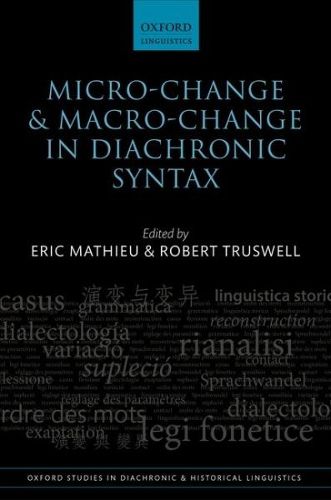Readings Newsletter
Become a Readings Member to make your shopping experience even easier.
Sign in or sign up for free!
You’re not far away from qualifying for FREE standard shipping within Australia
You’ve qualified for FREE standard shipping within Australia
The cart is loading…






The chapters in this volume address the process of syntactic change at different granularities. The language-particular component of a grammar is now usually assumed to be nothing more than the specification of the grammatical properties of a set of lexical items. Accordingly, grammar change must reduce to lexical change. And yet these micro-changes can cumulatively alter the typological character of a language (a macro-change). A central puzzle in diachronic syntax is how to relate macro-changes to micro-changes. Several chapters in this volume describe specific micro-changes: changes in the syntactic properties of a particular lexical item or class of lexical items. Other chapters explore links between micro-change and macro-change, using devices such as grammar competition at the individual and population level, recurring diachronic pathways, and links between acquisition biases and diachronic processes. This book is therefore a great companion to the recent literature on the micro- versus macro-approaches to parameters in synchronic syntax. One of its important contributions is the demonstration of how much we can learn about synchronic linguistics through the way languages change: the case studies included provide diachronic insight into many syntactic constructions that have been the target of extensive recent synchronic research, including tense, aspect, relative clauses, stylistic fronting, verb second, demonstratives, and negation. Languages discussed include several archaic and contemporary Romance and Germanic varieties, as well as Greek, Hungarian, and Chinese, among many others.
$9.00 standard shipping within Australia
FREE standard shipping within Australia for orders over $100.00
Express & International shipping calculated at checkout
The chapters in this volume address the process of syntactic change at different granularities. The language-particular component of a grammar is now usually assumed to be nothing more than the specification of the grammatical properties of a set of lexical items. Accordingly, grammar change must reduce to lexical change. And yet these micro-changes can cumulatively alter the typological character of a language (a macro-change). A central puzzle in diachronic syntax is how to relate macro-changes to micro-changes. Several chapters in this volume describe specific micro-changes: changes in the syntactic properties of a particular lexical item or class of lexical items. Other chapters explore links between micro-change and macro-change, using devices such as grammar competition at the individual and population level, recurring diachronic pathways, and links between acquisition biases and diachronic processes. This book is therefore a great companion to the recent literature on the micro- versus macro-approaches to parameters in synchronic syntax. One of its important contributions is the demonstration of how much we can learn about synchronic linguistics through the way languages change: the case studies included provide diachronic insight into many syntactic constructions that have been the target of extensive recent synchronic research, including tense, aspect, relative clauses, stylistic fronting, verb second, demonstratives, and negation. Languages discussed include several archaic and contemporary Romance and Germanic varieties, as well as Greek, Hungarian, and Chinese, among many others.